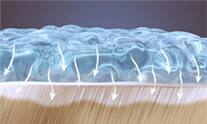There are many ways to whiten your teeth-from whitening toothpastes and other products that can remove surface stains, to light-activated whitening techniques in a dentist's office and can produce dramatic results.
All whitening techniques work in one of two ways:
 Bleaching removes both deep & surface stains.
Bleaching removes both deep & surface stains.Bleaching procedures change your natural tooth color, usually anywhere from three to five shades brighter. In-office (chairside) whitening and at-home (tray) whitening both rely on bleaching. Bleaches contain an active ingredient, most often carbamide peroxide or hydrogen peroxide in concentrations of 10-22%, which helps remove both internal discolorations and surface stains.
• A light-activated whitening session in a dentist's office, sometimes called chairside bleaching, results in instantly and often dramatically whiter teeth. However, after a year or so, your teeth may become slightly discoloured again and develop new stains.
• A custom mouthpiece tray is made by your dentist for in-home bleaching. You typically wear it several hours a day or overnight for two weeks. When you notice new staining, you just wear the tray again for a night or two to take the stains off.
• Ask your dentist for over-the-counter products for whitening teeth (those found in a Pharmacy)
 Abrasion removes most external stains.
Abrasion removes most external stains.Non-bleaching procedures work by physical action to help remove surface stains. All toothpastes rely on mild abrasion to remove surface stains between dental visits. Whitening toothpastes have special polishing agents that provide additional stain removal. A professional cleaning by a dentist or hygienist also uses abrasion and polishing to remove most external staining caused by food and tobacco.
Copyright © 2002, 2003 Colgate-Palmolive Company. All rights reserved.







